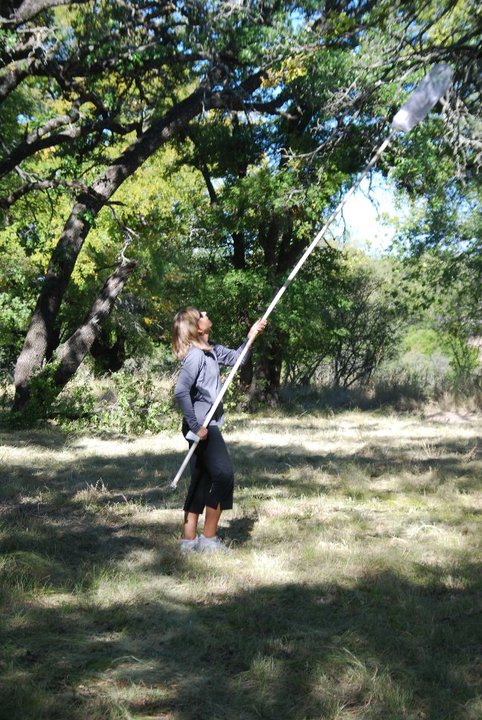The Monarch butterfly migration is happening in Central Texas. Jenny Singleton, a seasoned Monarch tagger and preschool teacher from Grapevine, reported Monarch butterflies roosting at her ranch near Menard last weekend and local reports have Monarch butterflies wafting through town, some leaving eggs on milkweed in their wake.

Jenny Singleton’s “Tag Team” of Monarch Butterfly Taggers on the San Saba
Arriving at her place about 10 AM last Saturday, Singleton immediately visited the San Saba River bottom where Monarch butterflies typically roost in mid October.
“I was thinking that maybe the night before’s butterflies might still be there while it was still cool,’’ Singleton shared via email. ‘’As I drove through…butterflies were fluttering everywhere – I felt the same magic I do every time I come across this.”
Singleton and her “tag team” of nine volunteers tagged a total of 367 Monarch butterflies in just 48 hours. “Not record numbers, but certainly fun, and always special,” she says.
The weekend is an annual event for Singleton, who tagged more than 1,200 butterflies at her place in 2008, a banner butterfly year. A devoted participant in Monarch Watch’s citizen scientist program that helps monitor the Monarch butterfly migration, Singleton has also had several of her tagged Monarchs recovered and recorded in Michoacan, Mexico.
When faced with the spectacle of a Monarch butterfly roosting spot, it’s near impossible to not be moved. I remember my first encounter on the Llano River as an enchanting moment: I stepped out of a kayak on a crisp October afternoon, welcomed by a fluttering eruption of orange-black-and-gold Monarch butterflies settling on pecan branches for the evening. I tagged 25 in 15 minutes and have been hooked ever since.
I missed the peak week this year because of a trip to visit my son who’s studying abroad, but was able to keep up with the migration through the web. Thanks to Singleton’s dispatches, reports on Monarch Watch’s Facebook page, and updates on the Journey North website, I didn’t miss a (butterfly) beat.
Meanwhile, scientists insist that the generation of Monarchs that migrate do not lay eggs and reproduce. Yet here in Central Texas we consistently see Monarchs laying eggs this time of year. What gives?
Not all Monarchs migrate, says Dr. Daniel Najera, a professor of entomology at the University of the Incarnate Word, who studied with the founders of Monarch Watch at the University of Kansas at Lawrence.
“If a monarch is mating or laying eggs, it’s not a ‘truly migrating monarch,’ ” says Dr. Najera. “If it was truly migrating, it would be in a reproductive diapause. Just because it’s fall does not mean all monarchs have become truly migrating.”
Here in Central and South Texas, we often collect Monarch butterfly caterpillars well into November. Check the undersides of milkweed leaves if you have plants in your garden. Our first frost generally doesn’t hit until November 15, so another batch of Monarch butterflies still has time to hatch and catch a wind wave to Michoacan before the season ends.
If you spot any Monarchs passing through, or find any eggs, please let us know by leaving a comment below.

Visited the migration in Del Rio last Friday. Saw at least 5000+ monarchs in one small backyard along San Felipe Creek…beautiful! Almost like being in Mexico!
Wow, that’s great. Wish I could have seen it myself. Keep the reports coming, Mary.
I live in Maryland and would love to witness the masses of Monarchs during migration ~ anyone have a suggestion as to the closest location to Maryland and when? I know I’ve missed it this year but would love to plan a trip for next year!
Unfortunately, Mary, it’s a hard thing to plan as Monarchs are unpredictable. I saw this year that they moved through Cape May en masse. The video was striking. Here’s the link: http://www.flickr.com/photos/sgalick/5045717086/ Some years we seem them here in Texas along the river systems, but they also can detour along the Gulf Coast. Good luck!